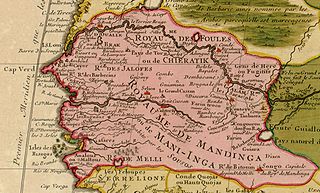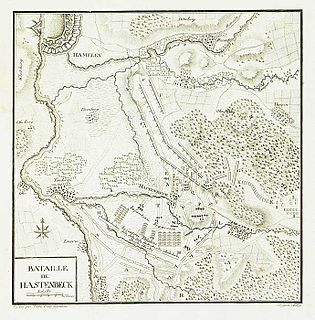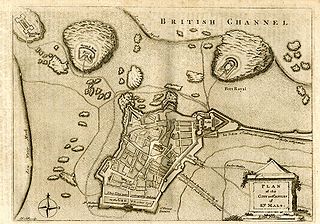Related Research Articles

William Pitt, 1st Earl of Chatham, was a British statesman of the Whig group who served as Prime Minister of Great Britain in the middle of the 18th century. Historians call him Chatham or William Pitt the Elder to distinguish him from his son, William Pitt the Younger, who was also a prime minister. Pitt was also known as the Great Commoner, because of his long-standing refusal to accept a title until 1766.

The French and Indian War (1754–1763) was a theater of the Seven Years' War, which pitted the North American colonies of the British Empire against those of the French, each side being supported by various Native American tribes. At the start of the war, the French colonies had a population of roughly 60,000 settlers, compared with 2 million in the British colonies. The outnumbered French particularly depended on the natives.
The first written records of the region come from Arab traders in the 9th and 10th centuries. In medieval times, the region was dominated by the Trans-Saharan trade and was ruled by the Mali Empire. In the 16th century, the region came to be ruled by the Songhai Empire. The first Europeans to visit the Gambia River were the Portuguese in the 15th century, in 1445, who attempted to settle on the river banks, but no settlement of significant size was established. Descendants of the Portuguese settlers remained until the 18th century. In the late 16th century, English merchants attempted to begin a trade with the Gambia, reporting that it was "a river of secret trade and riches concealed by the Portuguese."

Admiral of the Fleet George Anson, 1st Baron Anson, was a Royal Navy officer. Anson served as a junior officer during the War of the Spanish Succession and then saw active service against Spain at the Battle of Cape Passaro during the War of the Quadruple Alliance. He then undertook a circumnavigation of the globe during the War of Jenkins' Ear. Anson commanded the fleet that defeated the French Admiral de la Jonquière at the First Battle of Cape Finisterre during the War of the Austrian Succession.

Senegambia, officially the Senegambia Confederation, was a loose confederation in the late 20th century between the West African countries of Senegal and its neighbour the Gambia, which is almost completely surrounded by Senegal. The confederation was founded on 1 February 1982 following an agreement between the two countries signed on 12 December 1981. It was intended to promote cooperation between the two countries, but was dissolved by Senegal on 30 September 1989 after the Gambia refused to move closer toward union. The Senegambia Confederation should not be confused with the historic Senegambia region, generally shortened to the Senegambia.

The Battle of Minorca was a naval battle between French and British fleets. It was the opening sea battle of the Seven Years' War in the European theatre. Shortly after the war began British and French squadrons met off the Mediterranean island of Minorca. The French won the battle. The subsequent decision by the British to withdraw to Gibraltar handed France a strategic victory and led directly to the Fall of Minorca.

The Anglo–Spanish War was a military conflict fought between Britain and Spain as part of the Seven Years' War. It lasted from January 1762 until February 1763 when the Treaty of Paris brought it to an end.

The British expedition against Guadeloupe was a military action from January to May 1759, as part of the Seven Years' War. A large British force had arrived in the West Indies, intending to seize French possessions. After a six-month-long battle to capture Guadeloupe they finally received the formal surrender of the island, just days before a large French relief force arrived under Admiral Maximin de Bompart.

The Seven Years' War (1756–1763) was a global conflict between Great Britain and France for global pre-eminence. Britain, France and Spain fought both in Europe and overseas with land-based armies and naval forces, while Prussia sought territorial expansion in Europe and consolidation of its power. Long-standing colonial rivalries pitting Britain against France and Spain in North America and the Caribbean islands were fought on a grand scale with consequential results. In Europe, the conflict arose from issues left unresolved by the War of the Austrian Succession (1740–1748). Prussia sought greater influence in the German states, while Austria wanted to regain Silesia, captured by Prussia in the previous war, and to contain Prussian influence.

The Raid on Cherbourg took place in August 1758 during the Seven Years' War when a British force was landed on the coast of France by the Royal Navy with the intention of attacking the town of Cherbourg as part of the British government's policy of "descents" on the French coasts.

Great Britain was one of the major participants in the Seven Years' War, which in fact lasted nine years, between 1754 and 1763. British involvement in the conflict began in 1754 in what became known as the French and Indian War. However the warfare in the European theater involving countries other than Britain and France commenced in 1756. Britain emerged from the war as the world's leading colonial power, having gained all of New France in North America, ending France's role as a colonial power there. Following Spain's entry in the war in alliance with France in the third Family Compact, Britain captured the major Spanish ports of Havana, Cuba and Manila, in the Philippines in 1762, and agreed to return them in exchange for Florida, previously controlled by Spain. The Treaty of Paris in 1763 formally ended the conflict and Britain established itself as the world's pre-eminent naval power.

France was one of the leading participants in the Seven Years' War which lasted between 1756 and 1763. France entered the war with the hope of achieving a lasting victory against Prussia, Britain, and their German allies and with the hope of expanding its colonial possessions.(1)

Peregrine Thomas Hopson was a British army officer who commanded the 40th Regiment of Foot and saw extensive service during the eighteenth century and rose to the rank of Major General. He also served as British commander in Louisbourg during the British occupation between 1746–1749, then became Governor of Nova Scotia and later led a major expedition to the West Indies during the Seven Years' War during which he died.

The Raid on Rochefort was a British amphibious attempt to capture the French Atlantic port of Rochefort in September 1757 during the Seven Years' War. The raid pioneered a new tactic of "descents" on the French coast, championed by William Pitt who had taken office a few months earlier.
The French conquest of Senegal started in 1659 with the establishment of Saint-Louis, Senegal, followed by the French capture of the island of Gorée from the Dutch in 1677, but would only become a full-scale campaign in the 19th century.

The capture of Senegal took place in 1758 during the Seven Years' War with France, as part of a concerted British strategy to weaken the French economy by damaging her international trade. To this end, a succession of small British military expeditions landed in Senegal and captured Gorée and Fort Saint Louis, the French slave fort located at Saint-Louis, seizing French vessels and supplies. By late 1758 the whole of the French colony on the Senegalese coast had been captured by the British, with administrative matters being handled by the first British Governor of Senegal, Lieutenant Colonel Richard Worge.

The Capture of Gorée occurred in December 1758 when a British naval expedition led by Augustus Keppel against the French island of Gorée off the coast of Senegal during the Seven Years' War.

The Capture of Belle Île was a British amphibious expedition to capture the French island of Belle Île off the Brittany coast in 1761, during the Seven Years' War. After an initial British attack was repulsed, a second attempt under General Studholme Hodgson forced a beachhead. A second landing was made, and after a six-week siege the island's main citadel at Le Palais was stormed, consolidating British control of the island. A French relief effort from the nearby mainland was unable to succeed because of British control of the sea. The British occupied the island for two years before returning it in 1763 following the Treaty of Paris.

The Invasion of Hanover took place in 1757 during the Seven Years' War when a French army under Louis Charles César Le Tellier, duc d'Estrées advanced into the Electorate of Hanover and neighbouring German states following the Battle of Hastenbeck. French forces overran most of Hanover forcing the Hanoverian Army of Observation, intended to defend the Electorate, to Stade on the North Sea coast. At the Convention of Klosterzeven the Duke of Cumberland agreed to disband his army and acknowledge the French occupation of the Electorate.

The Raid on St Malo took place in June 1758 when an amphibious British naval expedition landed close to the French port of St Malo in Brittany. While the town itself was not attacked, as had been initially planned, the British destroyed large amounts of shipping before re-embarking a week later. The naval forces were under the command of Richard Howe while the army was led by the Duke of Marlborough and Lord Sackville.